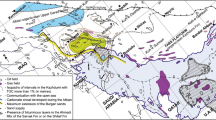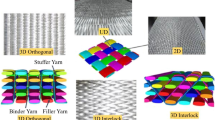Abstract
The effect of heat and fire on the mechanical properties and failure of polymer composite materials used in naval ship structures is investigated. Coupled thermal-mechanical models are presented for predicting the loss in strength and failure of load-bearing polymer laminates when heated from one-side. The thermal component of the models predicts the temperature and decomposition rate of a laminate. Using this information, several mechanical models based on progressive softening analysis or laminate analysis can be used to predict the reduction in strength and time-to-failure. A coupled thermal-mechanical model that is solved using finite element analysis is also presented. Experimental fire-under-load tests are performed on several types of polymer laminate materials to evaluate the accuracy of the models. The tests were performed at different heat flux levels between 10 kW/m2 and 75 kW/m2, which is equivalent to surface temperatures between about 250°C and 700°C. The temperature, mass loss and char formation of a laminate can be accurately predicted for a wide range of thermal conditions using the models. The models can also predict the time-to-failure of laminates under static tension or compression loading. The models presented in this chapter are considered useful analytical tools for naval architects to estimate the loss in mechanical performance and time-to-failure of composite ship materials in fire.

















Similar content being viewed by others
Notes
In the model the fiber reinforcement in the laminate is assumed to be thermally stable, and does not decompose with the evolution or absorption of heat. This assumption is valid for laminates containing non-combustible fibers (e.g. glass, basalt, silica). It is possible to calculate the temperature of laminates containing combustible fibers (e.g. aramid, polyethylene) using an expanded form of the analysis presented here, although this case is not considered in the paper.
References
Smith CS (1990) Design of marine structures in composite materials. Elsevier Applied Science, London
Gaorik JE, Corroado JA, Kornbau RW (1991) An overview of composite developments for naval surface combatants. In: Proceedings of the 36th international SAMPE symposium, 15–18 April 1991, pp 1855–1867
Mouritz AP, Gellert E, Burchill P, Challis K (2001) Review of advanced composite structures for naval ships and submarines. Compos Struct 53:21–41
Anon (1995) French frigates designed for stealth. Naval Archit E172–173
Benson JL (1998) The AEM/S system, a paradigm-breaking mast, does to sea. J Naval Eng 110:99–103
Fisher KJ (1993) Is fire a barrier to shipboard composites? Adv Compos 20–26 (May/June)
Sorathia U, Lyon R, Gann R, Gritzo L (1996) Materials and fire threat. SAMPE J 32:8–15
Sorathia U (2004) Improving the fire performance characteristics of composite materials for naval applications. AMPTIAC Q 7:49–54
Sevart JL, Griffin OH, Gürdal Z, Warner GA (1990) Flammability and toxicity of materials for marine vehicles. Naval Eng J 45–54 (September)
Allison DM, Marchand AJ, Morchat RM (1991) Fire performance of composite materials in ships and offshore structures. Marine Struct 4:129–140
Sorathia U, Dapp T, Kerr J (1991) Flammability characteristics of composites for shipboard and submarine internal applications. In: Proceedings of the 36th international SAMPE symposium, San Diego, CA, 15–18 April 1991, pp 1868–1878
Gibson AG, Hume J (1995) Fire performance of composite panels for large marine structures. Plastics Rubbers Compos Process Appl 23:175–183
Egglestone GT, Turley DM (1994) Flammability of GRP for use in ship superstructures Fire Mater 18:255–260
Sorathia U, Gracik T, Ness J, Blum M, Le A, Scholl B, Long G (2000) Fire safety of marine composites. In: Proceedings of the 8th international conference on marine applications of composite materials, FL, 14–16 March, 2000
Koo JH, Muskopf B, Venumbaka S, Van Dine R, Spencer B, Sorathia U (2000) Flammability properties of polymer composites for marine applications. In: Proceedings of the 32nd international SAMPE technical conference, 5–9 November 2000, Paper No. 136
Gibson AG, Wu Y-S, Chandler HW, Wilcox JAD, Bettess P (1995) A model for the thermal performance of thick composite laminates in hydrocarbon fires. Revue de L’Institut Francais du Petrole 50:69–74
Henderson JB, Wiebelt JA, Tant MR (1985) A model for the thermal response of polymer composite materials with experimental verification. J Compos Mater 19:579–595
Bausano J, Boyd S, Lesko J, Case S (2003) Composite life under sustained compression and one-sided simulated fire exposure: characterization and prediction. In: Proceedings of composites in fire 3rd, 9th, 10th September 2003, University of Newcastle-upon-Tyne, UK
Lua J, O’Brien J (2003) Fire simulation for woven fabric composites with temperature and mass dependent thermal-mechanical properties. In: Proceedings of composites in fire 3rd, 9th 10th September 2003, University of Newcastle-upon-Tyne, UK
Mahieux CA, Reifsnider KL (2001) Property modeling across transition temperatures in polymer matrix composites: part 1: tensile properties. Polymer 42(7):3281–3290
Mahieux CA, Reifsnider KL (2002) Property modeling across transition temperatures in polymers: Application to thermoplastic systems. J Mater Sci 37:911–920
Mouritz AP, Mathys Z (1999) Post-fire mechanical properties of marine polymer composites. Compos Struct 47:643–653
Gibson AG, Wright PNH, Wu Y-S, Mouritz AP, Mathys Z (2003) Modeling residual mechanical properties of polymer composites after fire. Plastics Rubbers Compos 32:81–90
Gibson AG, Mouritz AP, Mathys Z (2004) The integrity of polymer composites during and after fire. J Compos Mater 38:1283–1306
Lui L, Holmes JW, Kardomateas GA, Birman V (2005) Compressive response of composites under combined fire and compressive loading. In: Gibson AG (ed) Proceedings of composites in fire - 4, 15–16 September 2005, University of Newcastle upon Tyne, CompositeLink.
Acknowledgements
This research was performed as part of a research project (P2.1.1) within the Cooperative Research Centre for Advanced Composite Structures (CRC-ACS). The study was supported by the United States Office of Naval Research (Grant No. N00014-04-10026) under the direction of Dr L. Couchman. One of us, AGG, would also like to acknowledge the support of the UK EPSRC. The authors thank Luke Bond (CRC-ACS) for conducting the elevated temperature tests and Peter Tkatchyk (RMIT) for constructing the radiant heat flux test apparatus and for assistance when conducting the tests. The technical assistance of Sarina Russo (DSTO) in measuring the temperature–time response of the laminates is also acknowledged.
Author information
Authors and Affiliations
Corresponding author
Rights and permissions
About this article
Cite this article
Mouritz, A.P., Feih, S., Mathys, Z. et al. Mechanical Property Degradation of Naval Composite Materials. Fire Technol 47, 913–939 (2011). https://doi.org/10.1007/s10694-009-0125-5
Published:
Issue Date:
DOI: https://doi.org/10.1007/s10694-009-0125-5




